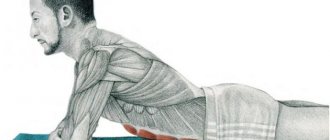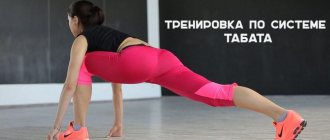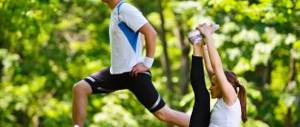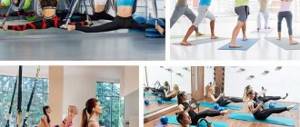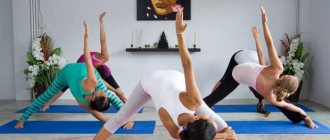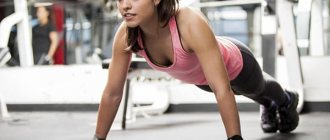What is stretching
Stretching is a special type of aerobics aimed at improving flexibility and stretching of ligaments, tendons and muscles. Regular stretching classes for beginners can improve blood circulation, the functioning of internal organs, joint mobility, and also prevent injuries resulting from unfortunate falls or unexpected sprains.
Stretching training does not have to be carried out under the guidance of an instructor. It can be done independently at home, even by beginners. In addition, stretching can be performed before and after physical training in the gym. Stretching prepares the muscles and also increases their flexibility, thereby allowing them to acquire more elastic forms.
Stretching isn't just about doing the splits. Training should be carried out regularly, including all parts of the spine, arms, legs, and fingers. In childhood, stretching is much easier, since the muscles are not yet blocked and the joints are more mobile than in adults. Therefore, if you start stretching from childhood, it will be much easier to maintain your body in optimal condition in adulthood.
Athletes must use stretching both before and after training. You can also do stretching regularly at home, without necessarily linking it to other types of training. You can stretch at home even while doing homework.
Exercises for doing the splits
Many people are interested in which complex is the best for quickly doing the splits. Include the following stretching exercises in your sports lessons:
- "Rider". Place your right leg forward and bend the knee to a right angle, and straighten your left leg and stretch it back. Start springing, trying to lower your pelvis as low as possible. In this case, you can lean on the floor or keep your arms raised vertically up. After 20-30 seconds, perform the exercise with your left leg forward.
- Passive stretching for splits. Lie down near a wall, pressing your buttocks against it as tightly as possible. Spread your legs as wide as you can and lie in this position for 30-40 seconds. If you want to make the exercise more challenging, wear weights on your legs. After this, gently “collect” your legs with your hands and rest a little.
Stretching exercises are the best way for beginners to achieve flexibility and grace at home. Do a set of stretching exercises regularly, and soon you will start receiving compliments!
Read here: home exercises for the back and spine - yoga and Surya Namaskar for beginners.
Who is stretching suitable for?
Stretching should be done not only by women, but also by men. It is perfect for people of all ages and even those who have problems with the ligamentous apparatus and joints, as well as beginners. Regular stretching exercises will ensure joint mobility, relieve muscle tension and teach ligaments to stretch. As a result, not only the entire body is rejuvenated, but the figure as a whole becomes more beautiful and fit.
Pregnant women can practice stretching both at home and in special classes with an instructor. At home, they should be carried out regularly and very carefully. It is necessary to monitor your well-being and do not try to stretch as intensely as possible. On the contrary, pregnant women should stretch very gently, but regularly. Then the results will be obvious soon.
Children can also practice at home with an instructor. Currently, children as young as two and a half years old are accepted for children's stretching classes. For professional gymnastics in the future, this type of load is ideal while the child is small.
Mothers can stretch their baby at home by gently stretching his back, arms and legs. The main thing is to do everything very gently, without unnecessary effort, focusing on the well-being of your child.
Stretching for beginners is just as important as other types of training. It is important to follow the rules and not resort to too intense loads at the very beginning of a beginner’s journey. A professional teacher will tell you how to perform the exercises correctly.
Stretching exercises
@ Pixabay/Pexels
Stretching refers to static (stationary) loads using body weight to improve blood flow to the muscles. Another important function of stretching should be noted - removing toxins from the muscles, which speeds up recovery.
It is very important that you need to perform stretching exercises only after strength training, when the muscles and ligaments are warmed up. Stretching before training on cold muscles is dangerous, fraught with damage and even muscle rupture.
Stretching during pregnancy
Stretching is indicated for pregnant women if they do not have health restrictions. Stretching is very popular in childbirth preparation courses, as it allows the expectant mother’s body to adapt to the rapid stress of childbirth.
Stretching improves muscle elasticity, joint mobility, saturates cells with oxygen, which provides the baby with the necessary elements. While performing stretching, a pregnant woman learns to control pain, this will help her in the future during childbirth.
With regular exercise, the expectant mother’s body adapts to the loads and they can be gradually increased. However, you should not be too zealous, since the pregnant woman’s body is very unpredictable.
When exercising at home, a pregnant woman should focus on static stretching, this will make it easier for her to control the degree of impact and intensity of the load. When training with a trainer, you can also perform dynamic exercises.
Contraindications
Every sport has them. Contraindications:
- Recent fractures. The bones must recover completely - this takes time. How much - only the doctor knows.
- Dislocations. If the ligaments have been injured, then there can be no question of any stretching.
- Problems with the spinal column.
- At risk of blood clots. This is possible with disturbances in the functioning of the cardiovascular system.
- Varicose veins Here you also need a consultation, this time with a vascular surgeon. Even if he approves of the classes, they must be carried out with great caution.
- Chronic joint diseases. This refers to the period of exacerbation.
Does stretching help you lose weight?
It is very useful for losing weight. It allows you to remove fat deposits from problem areas and improve the appearance of your figure as a whole, not only for professionals, but also for beginners. During stretching, the blood is saturated with oxygen, which, in turn, promotes fat burning.
In order to feel the results, you need to exercise regularly, at least three times a week. If you can't go to the gym, you can work out at home. During exercise, you need to carefully monitor your breathing, as it greatly affects the fat burning process.
There are some exercises that can help you lose weight. Bends, lunges, exercises from a lying position, they all have their value. It is important to select everything individually, taking into account your own characteristics.
Benefits of exercise
Not all people like to do intense workouts, such as aerobics or cardio. Stretching is ideal for such people. It is not aimed at excessive loads and is suitable for almost every person. It is suitable even for beginners.
The blood is saturated with oxygen, the ligaments and tendons are stretched, the muscles become more elastic, and the posture is straight. In addition, stretching allows you to lose excess weight, helps reduce cellulite, increases joint mobility and removes salt deposits.
Stretching exercises develop coordination and increase endurance even for beginners. Stretching exercises allow you to burn calories more effectively, even outside of other types of training. Scientists have proven that stretching increases calorie consumption not only during the workout itself, but also during other loads, even at rest.
Stretching several times a week helps achieve the following:
- reducing the appearance of cellulite;
- improving joint flexibility;
- reduction in body volume;
- improvement of the figure in general;
- optimization of metabolic processes;
- normalization of blood circulation.
Approximate set of exercises
Start with this complex, and over time add fixation time and more complex exercises.
- Stand up straight, with your legs slightly bent at the knees. Reach up with one hand, as if trying to reach the ceiling. Change your hand. Repeat the movement 5-10 times on each hand.
- Stand straight, fixing your feet at the knees. Place your left hand on your waist, and grab your head with your right, tilting it slightly to the right. Hold the position for 15-30 seconds.
- Sit on the floor. Spread your legs wider to the sides and place your hands behind your head. Reach each knee in turn, trying to fixate in the lower position for a while. Do 10 repetitions.
- Get on all fours. Pull your right leg back and your left arm forward. Try to hold this position for up to 30 seconds, trying to stretch your limbs as much as possible. Change limbs and repeat manipulations 10 times.
- Lie on the floor, raise your legs to your head, and clasp your feet with your hands. Fix for 20 seconds. Lower your legs, then repeat from the beginning 10 times.
- For chest mobility, perform the following exercise. Place a fitness mat on the floor and lie on it with your left side. Bend your knees so that the angle is 90 degrees. Extend both arms in front of you so that they lie perpendicular to your hips. After this position, without lifting your hips from the floor, smoothly raise your right arm and rotate your body (chest) to the right side. Stretch the back of your hand to the floor. After achieving the goal, return to the starting position and repeat from the beginning 6 times. After this, lie down on the other side and repeat all over again.
Take 10 second breaks between exercises. For greater clarity, you can view the photo and video course for beginners, which will help you carry out the training correctly.
“Cat fitness” is also called stretching. By exercising just a few times a week, you can achieve cat-like flexibility and grace. Only you yourself can take care of the beauty of your own body.
Basic rules for practicing stretching
When exercising, no matter at home or in a sports club, it is important to adhere to some rules. A training program for beginners usually includes a warm-up and cool-down, just like when performing other exercises.
By adhering to basic rules when performing exercises at home, you can get maximum results. It does not require the use of additional accessories, however, if there is excessive stiffness of the joints and muscles, special attributes may be needed.
At home, stretching for beginners is available without special preparation; you can make do with improvised materials. It is important to never start stretching without warming up. First, you should warm up your muscles, thereby preparing them for further stress. You can warm up your muscles with a light five-minute warm-up; this will be enough for home stretching exercises.
Beginners should not overcome severe pain. Pain occurs, but it should be moderate. If it increases, you need to stop training or reduce the intensity of the impact on this area, especially for beginners.
It often happens to beginners that the ligaments are stretched asymmetrically. The stretch is stronger on one leg than on the other. In this case, emphasis should be placed on the less stretched limb in order to achieve body symmetry.
It is advisable to relax during class. Stretching does not imply tension; on the contrary, the more you relax, the more effective the exercise will be.
It is also important to breathe properly and deeply. Breathing saturates the blood with oxygen, thereby allowing the ligaments to stretch more intensely. Don't rush while studying. It is better to complete them incompletely, within half an hour, than to rush and complete an hour-long program in half an hour. Stretching for beginners should not be rushed.
Before starting, beginners need to become familiar with the correct technique for performing it. Only a correctly performed exercise will be effective.
The slightest deviation from the norm can lead to unusual consequences
Smoothness of movement
During stretching, the capabilities of the body and the body as a whole increase. With regular exercise, the muscles become elastic and the ligaments begin to stretch better. However, not only beginners, but even those people who do it regularly, need to remember the smoothness of their movements.
During training, you must perform smooth movements, do not jerk or speed up the process. You should also breathe slowly and measuredly, inhaling and exhaling in several counts. Stretching for beginners should be done slowly and deliberately. Joints and muscles need gradual loading. During exercise, you need to keep your back straight to avoid spinal injury. You need to increase the intensity of exercises from time to time, without straining yourself too much in one day.
Only with a competent approach, even for beginners, can you get the desired result in the shortest possible time.
Breath
A hidden but very important element of stretching is breathing. Proper deep breathing will allow you to achieve results after just a few sessions. Much depends on the rhythm of the movements performed during stretching. At home, a person can control the rhythm, focusing on his own sensations. Even beginners need to strictly monitor their breathing.
A competent approach will allow even beginners to quickly recoup their efforts in training. During the exercise, as you inhale, try to feel the connection between the penetration of air into the tissues of your body. A kind of visualization. This technique will allow you to relax as much as possible, thereby increasing the effect of stretching.
Control of sensations
This type of activity is very effective for people of any age. Each person should take into account their individual characteristics and independently control their sensations during exercise, especially at home.
During training, beginners should not try too hard to avoid injury. If pain occurs, the intensity of the load on this area should be reduced. You can massage this area and then start training again.
Beginners should pay special attention to their own feelings. Control your every movement and listen to the body’s reaction. If classes are carried out at home, you should remember that during training you should not rush and do the exercises too intensely. It is better to do an additional workout per week than to effectively stretch all zones at once.
Benefits of classes
Systematic training will give you the following results:
- Relieving pain and muscle tension in different parts of the body by removing nerve and muscle blocks.
- Giving the body natural flexibility, partial rejuvenation.
- Working on those muscles that are not used during regular gym exercises.
- Stimulation of the cardiovascular system: activation of peripheral veins and arteries, this will eliminate congestion in blood vessels and prevent thrombosis and atherosclerosis.
- Slenderness, beautiful posture and fit appearance.
- Increased self-esteem, improved mood, feeling of satisfaction and comfort.
You can do stretching at home at any time of the day, and also alternate it with cardio and strength training. By studying stretching lessons for beginners, in just 4 weeks you will learn about many new capabilities of your body that you never even knew about before. This could be a lotus position or a leg thrown over the head.
Types of exercises
Stretching should be selected individually, taking into account the characteristics of each person. It has several types, each of which may suit one person, but not another person.
Stretching is divided into:
- degree of load;
- method of execution;
According to the degree of load, it can be deep and soft. The soft one is the one that is suitable for beginners and can be done at home. More intense - deep stretching. It is recommended for athletes, as well as people who are ready to work with a trainer. It is not suitable for beginners, as it places a tremendous load on unprepared tendons and muscles.
Stretching can also be static and dynamic, active, isometric, ballistic and proprioceptive neuromuscular.
The stretching complex is aimed at relaxing the muscles, so when performing exercises, you need to do everything smoothly and slowly. Dynamic involves alternating relaxing and tense exercises. Passive work stretches and warms up the muscles, active work involves more intense loads.
Isometric stretching is an alternation of tension, relaxation, and fixation. Ballistic is the most difficult and is suitable only for professionals. It should only be performed under the guidance of an instructor.
Passive stretching with a partner
It can be performed not only independently, but also in pairs with a partner. To achieve maximum flexibility, you should choose a knowledgeable person to partner with you. It will be difficult for two beginners to organize proper work.
Stretching with a partner can be bilateral or unilateral. Passive implies one-sided loads. Can be performed from any position: sitting, lying, standing. When performing exercises, the partner stretches the partner with the strength of his own body, controlling the intensity of the impact.
During these workouts, you need to be in full contact with your partner, he must feel well and rely on the sensations of being stretched to avoid injury and excessive tension.
With resistance
Ideally, before starting training, beginners should take at least a few lessons from an experienced instructor to understand the basic technique. This is especially true for stretching with resistance.
Performing this type of stretching involves almost the same thing as with a partner, however, in this case you should resist your partner with the strength of your muscles. This type is more intense compared to the classic one, since a larger range of movements is involved due to the actions of the partner.
Static
Static stretching refers to static movement. All movements are performed slowly and smoothly, basically keeping the torso in a static position for several seconds. For beginners, this type of stretching is better than others, since it allows you to control the degree of impact.
Ballistic
This type involves alternating static and dynamic exercises. They are performed springily, and the tempo must be selected individually. This method is not suitable for beginners, since it will be difficult for such people to maintain balance and control the intensity of the load.
Isolated
This type is important for better stretching of ligaments and joint mobility, especially for beginners. It is assumed that a certain body position is achieved, a delay in this position, and then a change to another. The main focus is on a specific muscle group, after which it is replaced by another group.
This type is suitable for both beginners and professional athletes, but beginners should be careful and carefully study the instructions.
Dynamic
Dynamic stretching is performed before other types of training. Usually, before cardio training, instructors suggest performing this stretching. It consists of dynamic movements with a wide amplitude, such as swings, lunges, swings. Perfectly prepares the body for further stress. Suitable even for beginners, but under the supervision of an instructor.
Types of stretching
Stretching is divided into several types:
- Dynamic.
- Static.
- Active.
- Ballistic.
- Neuromuscular.
For beginners, static is better. Its peculiarity is that it is more aimed at relaxing the muscles, and its exercises are performed smoothly and slowly.
It is this kind of training that promotes the soft development of all joints and helps strengthen the tendons.
The muscles receive, while remaining in a tense state, the necessary static load.
Leg exercises
Intense leg swings will allow you to achieve optimal stretching if performed correctly. The force of impact is directed to the gluteal muscles, as well as tendons.
To begin, you need to take a standing position with your feet shoulder-width apart. Swing forward and backward with one leg. Movements should be conscious and maximally concentrated on working the muscles. You should not swing your legs like a pendulum on a machine. Every movement must be verified.
The other leg can be slightly bent or kept straight. The back is also flat, the deflection in the lower back is removed. Approximately 3 minutes per leg. Next, repeat with the opposite leg.
Exercises for the pectoral muscles
The simplest exercise, but not for beginners, is the bridge. Everyone knows it from school and physical education lessons. The back muscles are worked. Performed from a supine position. Place your arms and legs on the floor and raise your back, forming a bridge. The higher your back reaches toward the ceiling, the stronger the stretch.
The benefits of stretching have been proven by scientific research. Regular classes will allow even beginners to achieve maximum results, provided that the complex is properly selected.
Stretching has a positive effect on the entire body, improves the functioning of human organs and systems, the figure acquires more attractive shape, and the mood noticeably improves.


